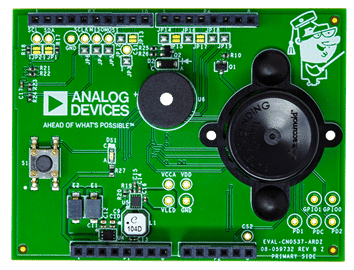The smoke detector design is compatible with Arduino, uses dual-wavelength technology for detection, and meets UL 217/UL 268 standards.

Since the 1970s, smoke detectors have been widely used in commercial and residential buildings. There are two main types of detectors: ionisation detectors, which use radioactive material to ionise the air and detect electrical imbalances, and photoelectric detectors, which use a light source angled away from a photodetector to detect increases in photodetector current. Although combining both types is often recommended, photoelectric smoke detectors are more popular due to their better reliability in detecting common house fires, faster response to smouldering fires, and lower risk of false alarms. In some regions of the United States, such as California and Massachusetts, laws require photoelectric smoke detectors.
The reference design of the smoke detector, CN0537 by Analog Devices, is developed and tested to comply with UL 217/UL 268 and similar smoke and fire detection standards. The hardware is compatible with the Arduino form factor and aims to expedite prototyping and evaluation of the embedded smoke detection algorithm.
The design includes an algorithm and a dataset based on the ADPD188BI optical module. The design is compatible with Arduino form factor controller platforms to facilitate easy and rapid development. The combination of software and embedded algorithms with the hardware enables the evaluation of smoke and fire tests specified in the 8th edition of the UL 217 and the 7th edition of the UL 268 standards. Verified algorithms are readily available for immediate use, accelerating the deployment of the smoke detection solution. Additionally, more data can be collected and integrated into the algorithm to adapt it for other standards.
The optical module is a comprehensive photometric system tailored for smoke detection applications. Incorporating the optical module instead of traditional, discrete smoke detector circuits significantly streamlines the design process, as the optoelectronics and the analogue front end (AFE) are already integrated into the module.
For smoke detection, the optical module employs a dual-wavelength technique. It features two integrated LEDs that emit light at different wavelengths: 470 nm (blue light) and 850 nm (infrared light). These LEDs are pulsed in separate time slots, and the light they emit is scattered back onto the device by particulate matter in the air, enabling the detection of smoke particles.
The two integrated photodetectors in the module capture the scattered light and generate output currents proportional to the intensity of the light received. These currents are then converted into digital code by the internal analogue front end (AFE). If the optical power of the LEDs is maintained at a constant level, any increase in the output values of the ADPD188BI over time would suggest a rise or accumulation of airborne particles.
Analog Devices has tested this reference design. It comes with a Bill of Material (BOM), Schematics, Gerber files, etc. You can find additional data about the reference design on the company’s website. To read more about this reference design, click here.








Hi Nidhi,
I need your help in this smoke detector reference design.
please call me 9350903148 or email me at – [email protected]
Regards,
Rajesh Sharma